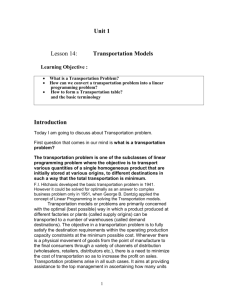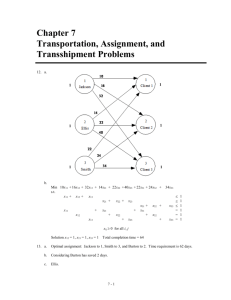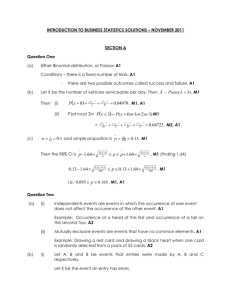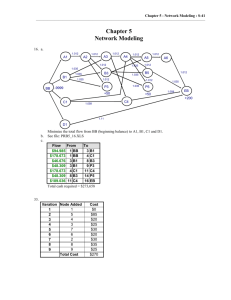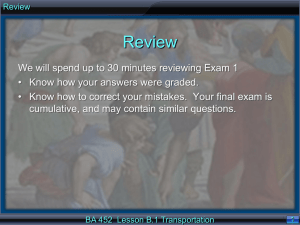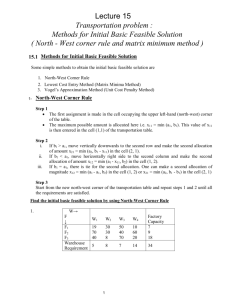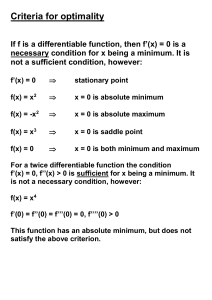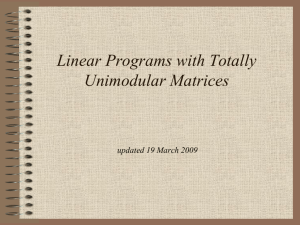Beitr¨ age zur Algebra und Geometrie Contributions to Algebra and Geometry
advertisement
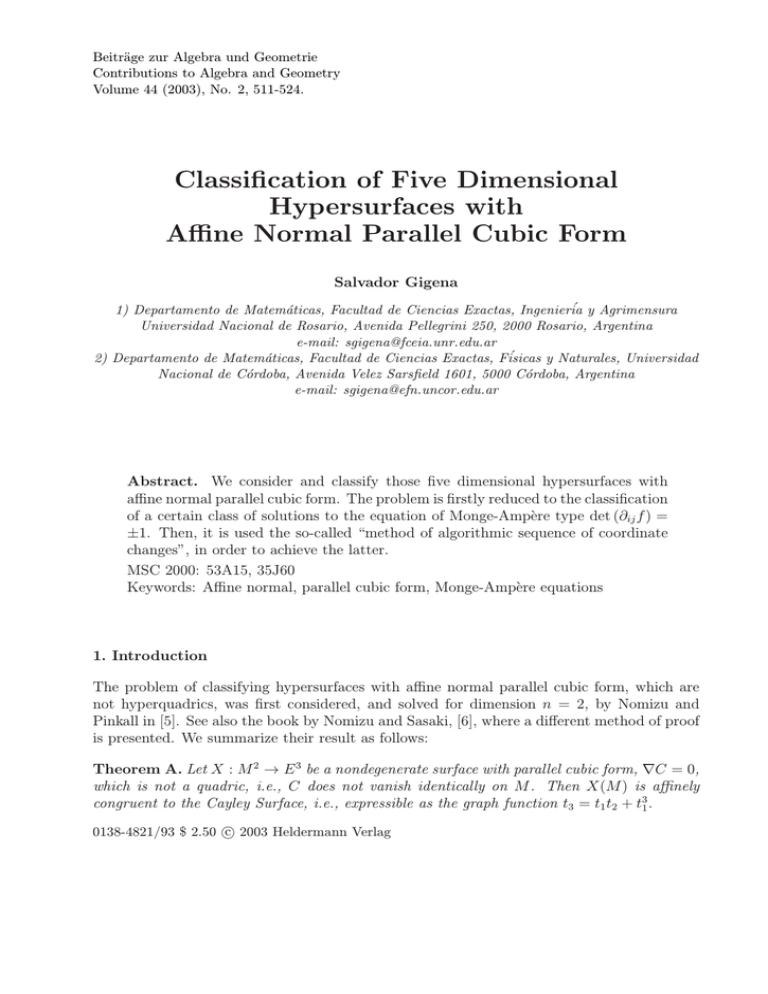
Beiträge zur Algebra und Geometrie Contributions to Algebra and Geometry Volume 44 (2003), No. 2, 511-524. Classification of Five Dimensional Hypersurfaces with Affine Normal Parallel Cubic Form Salvador Gigena 1) Departamento de Matemáticas, Facultad de Ciencias Exactas, Ingeniería y Agrimensura Universidad Nacional de Rosario, Avenida Pellegrini 250, 2000 Rosario, Argentina e-mail: sgigena@fceia.unr.edu.ar 2) Departamento de Matemáticas, Facultad de Ciencias Exactas, Físicas y Naturales, Universidad Nacional de Córdoba, Avenida Velez Sarsfield 1601, 5000 Córdoba, Argentina e-mail: sgigena@efn.uncor.edu.ar Abstract. We consider and classify those five dimensional hypersurfaces with affine normal parallel cubic form. The problem is firstly reduced to the classification of a certain class of solutions to the equation of Monge-Ampère type det (∂ij f ) = ±1. Then, it is used the so-called “method of algorithmic sequence of coordinate changes”, in order to achieve the latter. MSC 2000: 53A15, 35J60 Keywords: Affine normal, parallel cubic form, Monge-Ampère equations 1. Introduction The problem of classifying hypersurfaces with affine normal parallel cubic form, which are not hyperquadrics, was first considered, and solved for dimension n = 2, by Nomizu and Pinkall in [5]. See also the book by Nomizu and Sasaki, [6], where a different method of proof is presented. We summarize their result as follows: Theorem A. Let X : M 2 → E 3 be a nondegenerate surface with parallel cubic form, ∇C = 0, which is not a quadric, i.e., C does not vanish identically on M . Then X(M ) is affinely congruent to the Cayley Surface, i.e., expressible as the graph function t3 = t1 t2 + t31 . c 2003 Heldermann Verlag 0138-4821/93 $ 2.50 512 S. Gigena: Classification of Five Dimensional Hypersurfaces . . . The next known result on the topic is the article by L. Vrancken (for dimension n = 3), exposed in [7], and stated here as: Theorem B. Let X : M 3 → E 4 be a nondegenerate hypersurface with parallel cubic form, ∇C = 0, which is not a hyperquadric, C does not vanish identically on the hypersurface. Then X(M ) is affinely congruent to one of the following graph immersions a) t4 = t1 t2 + t23 + t31 . b) t4 = t1 t2 + t21 t3 + t23 . In a previous article [4] we introduced a new method of approaching the solution to the problem, different to the ones previously used by the other mentioned authors. We called it “algorithmic sequence of coordinate changes” and it consists, basically, in referring the hypersurface to a suitable linear coordinate system of the ambient space, and then making algorithmic adjustments into the Hessian matrix so that this can be integrated, fairly easily, to obtain the graph function representing the hypersurface. With this approach the classification depends strongly on two integer constants, that we labeled k and r, with 1 ≤ k ≤ n/2, 1 ≤ r ≤ n − 1, where n = dimension of the immersed manifold. Moreover, in that article we presented new proofs of the previously stated results and, then, extended the classification to dimension n = 4, by proving: Theorem C. Let X : M 4 → E 5 be a nondegenerate hypersurface with parallel cubic form, ∇C = 0, which is not a hyperquadric, C does not vanish identically on the hypersurface. Then X(M ) is affinely congruent to one of the following graph immersions: a) For k = r = 1: t5 = t1 t2 + t31 + t23 + t24 . b) For k = 1, r = 2: t5 = t1 t2 + t21 t3 + t23 + t24 . c) The case where k = 1, r = 3 is not possible, i.e., it does not exist any non degenerate hypersurface immersion with the required geometrical properties in the case where k = 1, r = 3. d) For k = 2, r = 1: t5 = t1 t2 + t31 + t3 t4 . e) For k = r = 2 we have the following subcases: e11 ) t5 = t1 t2 + a6 t31 + 2b t21 t3 + 2c t1 t23 + t3 t4 + d6 t33 . e12 ) t5 = t1 t2 + 2c t1 t23 + β 2c t2 t23 + t3 t4 + d6 t33 . f) For k = 2, r = 3: t5 = t1 t2 + a2 t2 t23 + t3 t4 + 2b t21 t3 + 2c t1 t23 + d6 t31 + 6e t33 . In each of cases e) and f) the constants must be related among them in order to fulfill the condition that the maximal rank of the complementary matrix equals respectively 2 and 3, i.e., r = 2, 3. It is the object of this paper to further extend the classification to the case of dimension n = 5, by proving the following: Main Theorem. Let X : M 5 → E 6 be a nondegenerate hypersurface with parallel cubic form, ∇C = 0, which is not a hyperquadric, C does not vanish identically on the hypersurface. Then X(M ) is affinely congruent to one of the following graph immersions: S. Gigena: Classification of Five Dimensional Hypersurfaces . . . 513 a) For k = r = 1: t6 = t1 t2 + 61 t31 + 12 (t23 + t24 + t25 ). b) For k = 1, r = 2: t6 = t1 t2 + t21 t3 + 12 (t23 + t24 + t25 ). c) The case where k = 1, r = 3 is not possible, i.e., it does not exist any non degenerate hypersurface immersion with the required geometrical properties in the case where k = 1, r = 3. d) The same situation happens with the case where k = 1, r = 4, i.e., it does not exist any non degenerate hypersurface immersion with the required geometrical properties in the case where k = 1, r = 4. e) For k = 2, r = 1: t6 = t1 t2 + 16 t31 + t3 t4 + 12 t25 . f) For k = r = 2 we have the following subcases: f1 ) t6 = t1 t2 + 61 a1 t31 + 21 a3 t21 t3 + 12 b3 t1 t23 + t3 t4 + 16 d3 t33 + 12 t25 . f2 ) t6 = t1 t2 + 21 a3 t1 t23 − 12 b2 a3 t2 t23 + t3 t4 + 12 t25 . g) For k = 2, r = 3 we have the following subcases: g1 ) t6 = t1 t2 + 21 at2 t23 + 16 bt31 + 12 ct21 t3 + 12 dt1 t23 + t3 t4 + 12 t25 . g2 ) t6 = t1 t2 + 16 a1 t31 + 12 a3 t21 t3 + 21 a5 t21 t5 + c5 t1 t3 t5 + t3 t4 + 16 f3 t33 + 12 f5 t23 t5 + 12 t25 . g3 ) t6 = t1 t2 + 12 a3 t21 t3 + 12 a4 t21 t4 + 21 c3 t1 t23 + t3 t4 + 16 f3 t33 + 12 t25 . h) For k = 2, r = 4: t6 = t1 t2 + 21 c1 t21 t4 + e1 t1 t3 t5 + t3 t4 + 12 e4 t23 t5 + 12 g1 t1 t23 + 16 g4 t33 + 1 h t2 t + 12 t25 . 2 1 1 3 In each of cases f), g) and h) the constants must be related among them in order to fulfill the condition that the maximal rank of the complementary matrix equals respectively 2, 3 and 4, i.e., r = 2, 3, 4. Remark. In previous papers we also referred to the cubic form C, alternatively, as the second fundamental form IIua , even though it is indeed a (0, 3)-tensor. The reason for this is because this form, together with the first fundamental form Iua (pseudo-Riemannian metric), determine the geometry of the immersed manifold. In particular, the fundamental existence and uniqueness theorems [1, 2]. However, in the current work no question regarding those matters arises. Thus, we refer presently to that (fundamental) geometrical object as just the cubic form C. 2. Summary of auxiliary results The following properties of the class under consideration were proved in [6]. They can also be proved by a different method [1, 2, 3, 4]. We include their statement here for the sake of completeness: Proposition 2.1. Let X : M n → E n+1 be a nondegenerate hypersurface with parallel cubic form, ∇C = 0, which is not a hyperquadric, C 6= 0. Then the following properties hold: 1) X(M ) is an improper affine hypersphere. 514 S. Gigena: Classification of Five Dimensional Hypersurfaces . . . 2) X(M ) is expressible in the form of Monge, i.e., a graph immersion and with respect to a suitable affine system of coordinates the graph function f satisfies a Monge-Ampère type equation det (fij ) = ±1. Moreover, it is representable as a polynomial function of degree exactly equal to three. 3) The following geometrical objects associated with X(M ) are all vanishing: IIIga = 0, ∧ Ric = 0, R = L = J = 0. 4) The first fundamental form Iua is indefinite. It turns out, too, that the conditions expressed by property 2) in the above Proposition are characterizing. In fact, we also proved, in [4], the following complementary result: Proposition 2.2. Let X : M n → E n+1 be a nondegenerate hypersurface which is expressible in the form of Monge, i.e., a graph immersion with respect to some affine system of coordinates in the ambient space, such that the graph function f is a polynomial function of degree exactly equal to three and satisfies the Monge-Ampère type equation det (fij ) = ±1. Then, X(M ) is an improper affine hypersphere with parallel cubic form, ∇C = 0, which is not a hyperquadric, i.e., with C 6= 0. We summarize next the method of algorithmic sequence of coordinate changes. To begin with, we apply the characterizing properties described by Propositions 2.1 and 2.2. Thus, by means of a translation, if necessary, we may assume that a linear system of coordinates has been chosen in the ambient space in such a way that the origin of coordinates lies in the hypersurface X(M ), that the hyperplane on which X(M ) is projectable is precisely the tangent hyperplane T0 (X(M )) to X(M ) at that point, and that the last coordinate is chosen in the (constant) direction of the affine normal vector field en+1 . We denote by (t1 , t2 , . . . , tn , tn+1 ) such an affine system of the vector space E, and represent the immersed hypersurface by equation X (t1 , t2 , . . . , tn ) = (t1 , t2 , . . . , tn , f (t1 , t2 , . . . , tn )) , with the point (t1 , t2 , . . . , tn ) varying in an open, connected subset U ⊂ T0 (X(M )), this last being obviously identifiable with Rn . By the choices made we have that f (0, . . . , 0) = f1 (0, . . . , 0) = · · · = fn (0, . . . , 0) = 0 (2.1) All of the remaining affine changes of coordinates shall occur in the tangent hyperplane and be of a linear nature, i.e., given by a system of linear equations like t∗i = X aki tk , t∗n+1 = tn+1 . Most usually the change shall be unimodular, i.e., with det aki = 1, although we may allow, occasionally, a rescaling in order to make the exposition less involved. S. Gigena: Classification of Five Dimensional Hypersurfaces . . . 515 Once such a change is made, in the new coordinate system, conditions expressed by equations (2.1) remain unchanged, and the Hessian matrix H(f ) changes to H ∗ (f ) = P H(f )P t , (2.2) where the matrix P is nonsingular and P t denotes the transpose of P . Now, it is well-known that, since P is expressible as a product of elementary matrices, the product to the left by P is equivalent to performing the corresponding row elementary operations to H(f ), and the product to the right by P t is obtained by performing the equivalent kinds of column elementary operations, both in the same order of execution. Thus, to obtain H ∗ (f ) from H(f ) we may do so by means of the following row and column elementary operations, which we define next: 1) Rij interchanges rows i and j. Cij interchanges columns i and j. P 2) Ri + aij Rj , with j 6= i, substitutes the i-th row by the linear combination as indicated. P Similarly, the notation for columns shall be indicated by Ci + aij Cj . Obviously, these two kinds of elementary operation are unimodular. The third kind consists of multiplying a row, and the corresponding column by a nonzero constant. This produces a rescaling. In [4], we also proved the following procedural result: Lemma 2.3. Let X : M n → E n+1 be a nondegenerate hypersurface with parallel cubic form, ∇C = 0, which is not a hyperquadric, C 6= 0. Then there exists an affine coordinate system in the ambient space such that X(M ) is expressible in the form of Monge (i.e., by means of a graph function f ) and such that the corresponding Hessian matrix is given by H(f ) = (fij ) = Jk + (xij ) 0 1 where Jk is a matrix with k ( ≥ 1) blocks of the form , in diagonal position, occupying 1 0 the first 2k diagonal entries the (possible) remaining diagonal elements are equal to 1, and with all of the rest of entries equal 0; while all of the entriesPof the matrix (xij ) are linear functions of the (domain) coordinates t1 , t2 , . . . , tn , i.e., xij = aijk tk . Moreover, the matrix of linear functions (xij ) is everywhere singular, whose maximal rank r is attained on an open, dense subset of the domain, and we have 1 ≤ r ≤ n − 1. The two positive integers k, with 1 ≤ k ≤ n/2, and r, with 1 ≤ r ≤ n − 1, are characteristic of, and determined by, each hypersurface with the required geometrical properties of having parallel second fundamental form with respect to the affine normal connection, i.e., ∇C = 0, and not being a hyperquadric, i.e., with C 6= 0. Thus, we emphasize again here that these two numbers play an essential role in the classification procedure. 3. Proof of the main theorem From Lemma 2.3 we have two possible values for k = 1, 2 ; and four for r = 1, 2, 3, 4. 516 S. Gigena: Classification of Five Dimensional Hypersurfaces . . . Cases a) k = r = 1; and b) k = 1, r = 2; are quite similar to the same labeled cases in Theorem C. Thus we omit their proofs. c) The third possible case corresponds to the values k = 1, r = 3. By Lemma 2.3 we can first reduce the Hessian matrix to x11 1 + x12 x13 x14 x15 1 + x12 x22 x23 x24 x25 x13 x23 1 + x33 x34 x35 (3.1) x14 x24 x34 1 + x44 x45 x15 x25 x35 x45 1 + x55 We define the vectors Xi := (x1i , x2i , x3i , x4i , x5i ). Then, it is easy to see, by means of suitable elementary operations, that the present case can be reduced to three subcases, labeled as: c1 ), c2 ) and c3 ). c1 ) Let us assume, first, that the vectors X1 , X2 and X3 are linearly independent on an open, dense subset of the domain, represent the remaining ones by Xi = ai1 X1 + ai2 X2 + ai3 X3 , i = 3, 4, and perform into the Hessian matrix defined by expression (3.1) the elementary operations suggested by the latter equality, i.e., Ri − ai1 R1 − ai2 R2 − ai3 R3 and Ci − ai1 C1 − ai2 C2 − ai3 C3 , i = 3, 4, to obtain x11 1 + x12 x13 −a42 −a52 1 + x12 x22 x23 −a41 −a51 x13 x23 1 + x33 −a43 −a53 , −a42 −a41 −a43 b44 b45 −a52 −a51 −a53 b45 b55 where b44 = 1 + 2a41 a42 + a243 , b45 = a41 a52 + a42 a51 + a43 a53 , b55 = 1 + 2a51 a52 + a253 . Besides, the 2 × 3 submatrix (aij ) must be different from zero (otherwise the Hessian determinant vanishes), and (the determinant of the 2 × 2 submatrix) |bij | = 0. From this we have two subcases c11 ) (bij ) = 0 or c12 ) (bij ) 6= 0. In the first subcase, c11 ), we must also have a41 6= 0, a42 6= 0, a51 6= 0, a52 6= 0. Then, we R5 , perform into the latter expression of the Hessian matrix the elementary operations R4 + aa42 52 a42 a51 a51 a53 a53 C4 + a52 C5 ; R2 + a52 R1 , C2 + a52 C1 ; R3 + a52 R1 , C3 + a52 C1 ; the entries −a41 , −a43 transformed into a041 , a043 , and one of these must be different from zero. It is easy to see that, by suitable further elementary operations, we can get the Hessian transformed, first into x11 1 + x12 b13 + x13 0 1 1 + x12 b22 + x22 b23 + x23 1 0 b13 + x13 b23 + x23 b33 + x33 0 0 , 0 1 0 0 0 1 0 0 0 0 and then, by also using the fact that the determinant of the latter 4 = b33 + x33 , and hence S. Gigena: Classification of Five Dimensional Hypersurfaces . . . 517 x33 = 0, b33 = −1, into x11 1 0 x14 x15 1 0 x14 x15 0 0 0 0 0 0 1 x35 0 1 x44 0 0 x35 0 1 . This is a contradiction, since we are assuming k = 1, so that this subcase is not possible. In the second subcase c12 ), we may assume b55 6= 0, write (b44 , b45 ) = c (b45 , b55 ) and perform elementary operations so as to transform the Hessian matrix into x11 1 + x12 x13 a042 0 1 + x12 x22 x23 a041 0 0 x13 . x 1 + x a 0 23 33 43 0 0 0 a42 a41 a43 0 0 0 0 0 0 1 Hence, some of the a04i must be nonvanishing and we can further reduce to two subcases: c121 ) a043 6= 0, c122 ) a042 6= 0. In the first of these we perform further elementary operations to get the Hessian equal to b11 + x11 b12 + x12 x13 0 0 b12 + x12 b22 + x22 x23 0 0 , x x x 1 0 13 23 33 0 0 1 0 0 0 0 0 0 1 but since the determinant of the latter equals minus the determinant of the 2×2 submatrix (bij + xij ), we must have |bij + xij | = 1, so that we can further diagonalize the latter to get the Hessian 1 0 x13 0 0 0 1 x23 0 0 x13 x23 x33 1 0 . 0 0 1 0 0 0 0 0 0 1 This is not possible, since we are assuming r = 3. In subcase c122 ) we perform elementary operations so as to x11 x12 x13 1 x12 b22 + x22 b23 + x23 0 x13 b23 + x23 b33 + x33 0 1 0 0 0 0 0 0 0 get the Hessian transformed into 0 0 0 . 0 1 518 S. Gigena: Classification of Five Dimensional Hypersurfaces . . . Here, again, we obtain that |bij + xij | = 1 and arrive, all the same, to a contradiction. c2 ) If we assume, second, that the vectors X2 , X3 and X4 are linearly independent, we find that this case is quite similar to the previous one and, therefore, omit its proof. c2 ) Finally, let us assume that the vectors X3 , X4 and X5 are linearly independent, write the other ones as Xi = ai3 X3 + ai4 X4 + ai5 X5 , i = 1, 2 , and perform into the Hessian matrix defined by equation (3.1) the elementary operations Ri − ai3 R3 − ai4 R4 − ai5 R5 and Ci − ai3 C3 − ai4 C4 − ai5 C5 , i = 1, 2, to obtain b11 b12 −a13 −a14 −a15 b12 b22 −a23 −a24 −a25 −a13 −a23 1 + x33 , x x 34 35 −a14 −a24 x34 1 + x44 x45 −a15 −a25 x35 x45 1 + x55 where b11 = a213 + a214 + a215 , b12 = 1 + a13 a23 + a14 a24 + a15 a25 , b22 = a223 + a224 + a225 . Then, we must have the determinant |bij | = 0, but at the same time the 2×2 submatrix (bij ) 6= 0, the vectors (a13 , a14 , a15 ) 6= 0, (a23 , a24 , a25 ) 6= 0; and we may assume that (b12 , b22 ) = c (b11 , b12 ), for some c ∈ R. Thus, by performing the operations R2 − cR1 , C2 − cC1 , if necessary, we may further assume that b12 = b22 = 0, b11 6= 0. Next, it is easy to see that we can perform operations to transform the Hessian matrix into b11 0 0 0 0 0 0 a023 a024 a025 , 0 a023 1 + x33 x x 34 35 0 0 a24 x34 1 + x44 x45 x35 x45 1 + x55 0 a025 where we must have the vector (a023 , a024 , a025 ) 6= 0. Thus, further elementary operations allow to write the Hessian 1 0 0 0 0 0 0 1 0 0 0 1 x33 x34 x35 . 0 0 x34 1 0 0 0 x35 0 1 However, here we would have r < 3, so that this subcase is also not possible, as were the previous ones. As a consequence, the whole case c) cannot happen. d) The fourth case corresponds to the values k = 1, r = 4; and it is easy to see that this reduces to two subcases: d1 ) X2 , X3 , X4 and X5 are linearly independent; d2 ) The linearly independent vectors are X1 , X2 , X3 and X4 . The proof of both of these follow a pattern similar to the previous case and to case c) in Theorem C. Thus, we omit it. e) If we consider now the case k = 2, r = 1, it is easy to see that this also reduces to two subcases: e1 ) x11 6= 0, on an open, dense subset of the domain; e2 ) x55 6= 0. S. Gigena: Classification of Five Dimensional Hypersurfaces . . . 519 Here again, the proof is quite similar to that in Theorem C, case d), and shall also be omitted. f) The sixth possible case corresponds to k = 2, r = 2; which can be reduced to three subcases: f1 ), f2 ), f3 ): f1 ) Let us assume, first, that the vectors X1 and X3 are linearly independent, represent the remaining ones by Xi = ai1 X1 + ai3 X3 , i = 2, 4, 5; and perform into the Hessian matrix for this case x11 1 + x12 x13 x14 x15 1 + x12 x22 x23 x24 x25 x13 x23 x33 1 + x34 x35 (3.2) x14 x24 1 + x34 x44 x45 x15 x25 x35 x45 1 + x55 the elementary operations Ri − ai1 R1 − ai3 R3 and Ci − ai1 C1 − ai3 C3 , i = 2, 4, 5, to obtain x11 1 x13 0 0 1 b22 0 b24 b25 x13 0 x33 1 0 , 0 b24 1 b44 b45 0 b25 0 b45 1 where we must have that the 3×3 submatrix formed with rows and columns 2, 4 and 5 is singular, i.e., with vanishing determinant. Then, there are two subcases that we label f11 ) and f12 ): f11 ) Suppose that (b24 , b44 , b45 ) = c (b22 , b24 , b25 ) + d (b25 , b45 , 1) , for some c, d ∈ R. Then, by making suitable elementary operations we can transform the above so as to have the vector (b24 , b44 , b45 ) = 0, with the rest of entries the same as before. Next, by computing the determinant we obtain ∆ = 1 + (b225 − b22 ) x11 , so that we have two possibilities: f111 ) b225 − b22 = 0, or f112 ) x11 = 0. f111 ) We have b225 − b22 = 0, and perform into the Hessian matrix the elementary operations R2 − b25 R5 , C2 − b25 C5 , to obtain x11 1 x13 0 0 1 0 0 0 0 x13 0 x33 1 0 , 0 0 1 0 0 0 0 0 0 1 with the condition x11 x33 − x213 6= 0. Then, straightforward integration allows to write the solution as t6 = t1 t2 + 16 a1 t31 + 12 a3 t21 t3 + 12 b3 t1 t23 + t3 t4 + 16 d3 t33 + 12 t25 . f112 ) If we assume now that x11 = 0, we may perform into the Hessian matrix the elementary operations R2 − b25 R5 , C2 − b25 C5 , to obtain 520 S. Gigena: Classification of Five Dimensional Hypersurfaces . . . 0 1 x13 1 2b2 0 x13 0 x33 0 0 1 0 0 0 0 0 1 0 0 with 2b2 = b22 − b225 . Finally, it is easy to see that the 0 1 x13 1 0 −b2 x13 x13 −b2 x13 x33 0 0 1 0 0 0 0 0 0 0 1 , Hessian matrix can be reduced to 0 0 0 0 1 0 . 0 0 0 1 The latter can be integrated straightforwardly to obtain the solution t6 = t1 t2 + 12 a3 t1 t23 − 12 b2 a3 t2 t23 + t3 t4 + 12 t25 . f12 ) If we assume now that (b22 , b24 , b25 ) = c (b24 , b44 , b45 ) + d (b25 , b45 , 1) , for some c, d ∈ R, it can be shown, by a quite similar procedure, that this subcase produces the same kind of solutions as before. f2 ) We assume, next, that the vectors X1 and X2 are the linearly independent ones, write Xi = ai1 X1 +ai2 X2 , i = 3, 4, 5, and perform the operations Ri −ai1 R1 −ai2 R2 and Ci −ai1 C1 −ai2 C2 , i = 3, 4, 5, to obtain x11 1 + x12 −a32 −a42 −a52 1 + x12 x22 −a31 −a41 −a51 −a32 −a31 b33 b34 b35 , −a42 −a41 b34 b44 b45 −a52 −a51 b35 b45 b55 where we must have, on the indicated submatrices, the conditions: (aij ) 6= 0, (bij ) 6= 0, |bij | = 0. Then, we may diagonalize the submatrix (bij ), and execute further elementary operations so as to transform the Hessian into three possible forms labeled f21 ), f22 ), f23 ). The careful analysis of these subcases gives rise to solutions which are the same as the ones quoted before, with some of the constants vanishing. f3 ) Let us assume, finally, that the vectors X4 and X5 are linearly independent. Then again, this subcase repeats the same solutions as those in f2 ). g) The seventh possible case corresponds to the values k = 2, r = 3, and again we can initially reduce this to three subcases: g1 ), g2 ), g3 ). g1 ) We assume, first, that the vectors X1 , X2 and X3 are linearly independent, represent Xi = ai1 X1 + ai2 X2 + ai3 X3 , i = 4, 5, and perform into the Hessian matrix, represented by expression (3.2), the operations Ri − ai1 R1 − ai2 R2 − ai3 R3 , and Ci − ai1 C1 − ai2 C2 − ai3 C3 , i = 4, 5, to get S. Gigena: Classification of Five Dimensional Hypersurfaces . . . x11 1 + x12 x13 −a42 −a52 1 + x12 x22 x23 −a41 −a51 x13 x23 x33 1 0 −a42 −a41 1 b44 b45 −a52 −a51 0 b45 b55 521 . Then, it is easy to determine that we must have the 2 × 2 submatrix (bij ) 6= 0, |bij | = 0. Hence, by means of suitable operations we can transform the latter expression into a11 + x11 a12 + x12 x13 0 0 a12 + x12 a22 + x22 x23 0 0 . x x x 1 0 13 23 33 0 0 1 0 0 0 0 0 0 1 Next, we proceed to diagonalize the 2 × 2 submatrix (aij ) which, by the conditions of the problem, can be made in only one possible way, so that the above Hessian takes the form x11 1 + x12 x13 0 0 1 + x12 x22 x23 0 0 x13 , x x 1 0 23 33 0 0 1 0 0 0 0 0 0 1 but then, by evaluating the determinant, we come to the conclusion that we must have x12 = 0, x11 x22 = 0, and we may assume that x22 = 0. Hence, we integrate to obtain the solution t6 = t1 t2 + 21 at2 t23 + 61 bt31 + 12 ct21 t3 + 12 dt1 t23 + t3 t4 + 16 et33 + 12 t25 . Moreover, by the conditions of the problem we can perform further operations in order to make e = 0 in the above. Thus, we obtain the solution quoted as g1 ) in the statement of the theorem. g2 ) We assume, second, that the vectors X1 , X3 and X5 are linearly independent, represent Xi = ai1 X1 + ai3 X3 + ai5 X5 , i = 2, 4, and perform into the Hessian the operations Ri − ai1 R1 − ai3 R3 − ai5 R5 , and Ci − ai1 C1 − ai3 C3 − ai5 C5 , i = 2, 4, to obtain x11 1 x13 0 x15 1 b22 0 b24 −a25 x13 , 0 x 1 x 33 35 0 b24 1 b44 −a45 x15 −a25 x35 −a45 1 + x55 where we must have for the 2×2 submatrix (bij ) the condition |bij | = 0, and from this we obtain two subcases: g21 ) (bij ) = 0, g22 ) (bij ) 6= 0, that we analyze next: g21 ) Here, further elementary operations allow to transform the Hessian matrix into 522 S. Gigena: Classification of Five Dimensional Hypersurfaces . . . x11 1 x13 0 x15 1 x13 0 0 0 x33 0 1 0 x35 0 x15 0 0 1 x35 0 0 0 1 + x55 , and, since the determinant of the latter equals 4 = 1 + x55 , it follows that x55 = 0. Thus, by integrating, we obtain the solution quoted as g2 ) in the statement of the theorem, i.e., t6 = t1 t2 + 16 a1 t31 + 12 a3 t21 t3 + 12 a5 t21 t5 + c5 t1 t3 t5 + t3 t4 + 61 f3 t33 + 12 f5 t23 t5 + 12 t25 . g22 ) We may assume (b22 , b24 ) = c (b24 , b44 ) , c ∈ R, and transform the Hessian matrix into x11 1 x13 0 x15 1 0 0 0 0 x13 0 x33 1 . x 35 0 0 1 b44 0 x15 0 x35 0 1 + x55 By evaluating the determinant of the latter we obtain 4 = 1+x55 −b44 x33 −b44 (x33 x55 − x235 ) , from which we get the conditions x55 = b44 x33 , x33 x55 − x235 = 0. Now, if b44 < 0, we arrive at a contradiction since in such a case we would also have x√ 33 = x35 = x55 = 0, so that r < 3. Hence, we must have b44 > 0, and it follows that x35 = b44 x33 . Thus, by a couple of elementary operations we reduce the Hessian matrix to x11 1 x13 x14 0 1 0 0 0 0 x13 0 x33 1 0 . x14 0 1 0 0 0 0 0 0 1 The latter expression can be integrated immediately to give the solution t6 = t1 t2 + 16 a1 t31 + 12 a3 t21 t3 + 12 a4 t21 t4 + 12 c3 t1 t23 + t3 t4 + 16 f3 t33 + 12 t25 . Then, by the conditions of the problem, we can make further operations in order to have a1 = 0 in the above. Therefore, this gives the solution labeled as g3 ) in the statement of the theorem. g3 ) If we assume, finally, that the vectors X3 , X4 and X5 are linearly independent and repeat the procedure we arrive at the same kinds of solutions as before. So we omit this part of the argument. h) The eighth and last possible case corresponds to the values k = 2, r = 4. We can initially reduce this to two subcases: h1 ), h2 ). h1 ) We assume, first, that the vectors X1 , X2 , X3 and X4 are linearly independent, write X5 = a51 X1 +a52 X2 +a53 X3 +a54 X4 , and perform into the Hessian, represented by expression (3.2), suitable operations to obtain S. Gigena: Classification of Five Dimensional Hypersurfaces . . . x11 1 + x12 x13 x14 1 + x12 x22 x23 x24 x13 x23 x33 1 + x34 x14 x24 1 + x34 x44 −a52 −a51 −a54 −a53 −a52 −a51 −a54 −a53 b 523 , where b = 1 + 2 (a51 a52 + a53 a54 ) = 0, so that we must have a51 a52 6= 0 or a53 a54 6= 0, and we can assume a52 6= 0. Hence, by performing further operations we can express the Hessian matrix as x11 1 + x12 x13 x14 −a52 1 + x12 b22 + x22 b23 + x23 b24 + x24 0 . x13 b + x x 1 + x 0 23 23 33 34 x14 b24 + x24 1 + x34 x44 0 −a52 0 0 0 0 Then, by evaluating the determinant, we conclude that we may write a52 = −1, and that the 3×3 submatrix formed by rows and columns 2, 3, 4 has determinant equal to −1. Thus, by making suitable operations we may bring the above Hessian to x11 1 x13 x14 x15 1 0 0 0 0 x13 0 x33 1 x35 , x14 0 1 0 0 x15 0 x35 0 1 which can be integrated to obtain the solution t6 = t1 t2 + 12 c1 t21 t4 + e1 t1 t3 t5 + t3 t4 + 12 e4 t23 t5 + 12 f1 t21 t5 + 12 g1 t1 t23 + 16 g4 t33 + 12 h1 t21 t3 + 16 k1 t31 + 12 t25 . Finally, from the conditions of the problem we can make a couple of further operations in order to get f1 = k1 = 0 in the above equation, so to obtain the result quoted as h) in the statement of the theorem. h2 ) We assume, next, that the vectors X2 , X3 , X4 and X5 are linearly independent, express X1 = a12 X2 + a13 X3 + a14 X4 + a15 X5 , and perform into the Hessian appropriate operations to get b11 1 −a14 −a13 −a15 1 x22 x23 x24 x25 −a14 x23 , x 1 + x x 33 34 35 −a13 x24 1 + x34 x44 x45 −a15 x25 x35 x45 1 + x55 where we must have b11 = 0. Then, by performing further, easily determined elementary operations we can get the Hessian matrix expressed by 524 S. Gigena: Classification of Five Dimensional Hypersurfaces . . . x11 1 x13 x14 x15 1 x13 x14 x15 0 0 0 0 0 x33 1 + x34 x35 0 1 + x34 x44 x45 0 x35 x45 1 + x55 . Here, by evaluating the determinant we obtain the condition that the 3×3 principal submatrix formed by rows and columns 3, 4, 5 has determinant equal to −1. Thus, by the classifying procedure for dimension n = 3, we can reduce the above Hessian matrix to x11 1 x13 x14 x15 1 0 0 0 0 x13 0 x33 1 x35 , x14 0 1 0 0 x15 0 x35 0 1 which is the same as the previous case h1 ). The proof is concluded. We remark finally that, since some of the solutions listed in the main theorem contain constant parameters, i.e., cases f), g) and h), and taking into consideration the conditions to be fulfilled in each case, one could perform further reductions in every one of them. However, we have preferred to leave the solutions expressed as stated, because they represent the most general form. Aside from this fact, and the further possibility of performing rescalings, the solutions obtained are inequivalent for different values of the parameters, i.e., they do belong to different classes under the action of the unimodular affine group ASL (n + 1, R) . References [1] Gigena, S.: General affine geometry of hypersurfaces I. Math. Notae 36 (1992), 1–41. Zbl 0828.53009 −−−− −−−−−−−− [2] Gigena, S.: Constant Affine Mean Curvature Hypersurfaces of Decomposable Type. Proceedings of Symposia in Pure Mathematics, American Mathematical Society 54 (1993), 289–316. Zbl 0799.53012 −−−− −−−−−−−− [3] Gigena, S.: Ordinary Differential Equations in Affine Geometry: Differential Geometric Setting and Summary of Results. Math. Notae 39 (1997/98), 33–59. [4] Gigena, S.: On Affine Hypersurfaces with parallel Second Fundamental Form. Tôhoku Math. J. 54 (2002), 495–512. [5] Nomizu, K.; Pinkall, U.: Cayley Surfaces in Affine Differential Geometry. Tôhoku Math. J. 42 (1990), 101–108. cf. Tôhoku Math. J. 41 (1989), 589–596. Zbl 0684.53011 −−−− −−−−−−−− [6] Nomizu, K.; Sasaki, T.: Affine Differential Geometry, Geometry of Affine Immersions. Cambridge Tracts in Math. 111, Cambridge University Press, Cambridge 1994. [7] Vrancken, L.: Affine higher order parallel hypersurfaces. Ann. Fac. Sci. Toulouse Math. (5) IX (1988), 341–353. Zbl 0687.53011 −−−− −−−−−−−− Received August 2, 2001; revised version October 1, 2002
